Mount Hood, South Side Route, Mount Hood National Forest
February 17, 2008
Another day has gone by, and I'm older, fatter, dumber, and uglier. This is what I tell myself when I get out of the shower every morning and look at the six foot by four foot mirror in my bathroom. I suppose it gives me a healthy perspective on life. Today is going to be about average: Worse than yesterday, better than tomorrow. If such is really the case, I might as well go and try to do something before things really do go downhill. Like climb Mount Hood. In February.

I wish I could take credit for the idea, but I can't. We had it all worked out: Climb St. Helens over two relaxed days, with plenty of whiskey thrown in at camp. But then the St. Helens people could plow their road, despite it being down well below 3000 feet and on Friday afternoon Wayne spread the word that the road was closed. Three hours later I was sitting in The Spar drinking beer with Kevin and Wayne and we had a new plan: Mount Hood. It seems that the Hood people can plow a road 3500 feet higher than the St. Helens one. And so on Saturday afternoon I found myself in a silver Dodge Durango speeding down I-5 for Oregon and Mount Hood, the second most climbed mountain in the world.

This winter the snowfall in the Cascades and Olympics had been immense, and for the first time in months the avalanche danger was moderate and the weather forecast favorable. Instead of the usual iron skies and beating rain, we actually got a view of the mountain on our drive down. In the summer, Hood melts out thoroughly and becomes a giant dirt ball. But in the winter, it is exquisite.

After a few mis-turns, we hopped off I-84 and got onto HWY 26 for the blast to Government Camp, a small resort town at the base of the south slopes of Mount Hood. Government Camp is a nice town, unlike other resort towns, as it hasn't been completely developed (i.e, ruined) by big business. There isn't a Starbucks. There isn't a Westin. There isn't a McDonalds. There are places to eat and places to stay and places to buy trinkets. But it is still tasteful. How long it will stay that way is unclear, but Oregonians seem to have more sense than Coloradans, so perhaps for quite a while.

We checked into the dorm at the Mazama Lodge and then headed out to town for dinner. After waiting in line for fifteen minutes at the Ice Axe Grill (parties of 17 and 20 in front of us), we went down the street and dined at a greasy spoon before returning to the lodge for a few hours sleep. The lodge is run by the Mazama's, an Oregon based climbing group much like the Mountaineers. For $15, we got a bed in the down and access to all the facilities, including washers and driers, showers, flush toilets, and a warm place to hang out. It wasn't a big fancy place, but it was really nice and what I hope to find in a mountain town. I put my earplugs in and was asleep before 9, trying to nab as many minutes of sleep as possible before my alarm went off at 1:30 am.
The worst part of a glacier climb is the alpine start. It was cold at 2 am when we left the lodge and began the drive up to Timberline Lodge at 6100 feet, where our climb would start. There was no one else stirring in the parking lot when we got there and began gearing up. It was cold when we went through a quick avalanche beacon refresher. It was cold when I registered our party. Before we left at 3:40 am the parking lot was getting busier and busier as two groups of climbers from the Mazamas were gearing up for their own attempt at Hood. We beat them out of the parking lot, but a solo climber quickly ripped past us. The permits indicated two groups already on the mountain. My steps went crunch, crunch, crunch. Vanessa's sounded the same. Kevin's and Wayne's made a schlick, schlick, schlick sound as then glided on skis up the icy slope. In clear, stable weather Hood isn't a technical climb for the most part. There isn't any route finding to do on the south side: Just follow the ski lift up hill and then make for the big rock in front of you.

As we broke past the upper ski lift, the ground became too icy and steep for Wayne and Kevin to skin up. Wayne strapped his skis to his back, adding nearly 10 pounds to his load, while Kevin stashed his in the snow. We were nearing the 9000 foot level and could see the head lamps of many climbers below us.

But what was more impressive than the string of lights twinkling on the ice below was the rising of the sun. The worst part of a glacier climb is the alpine start. But it is also the best part. Getting to see the sun rise from high up on the flanks of a mountain is a real treat. There isn't anything like it in the world. I am a connoisseur of sunrises, and the only thing that comes close is the sunrise in the Mojave.

First the air turns purple. After thirty minutes of purpleness, the sun slowly begins to shed its light toward you, but not yet directly. It is still below the horizon, but its light is streaming overhead, lighting up with a pale orange turning to pink.
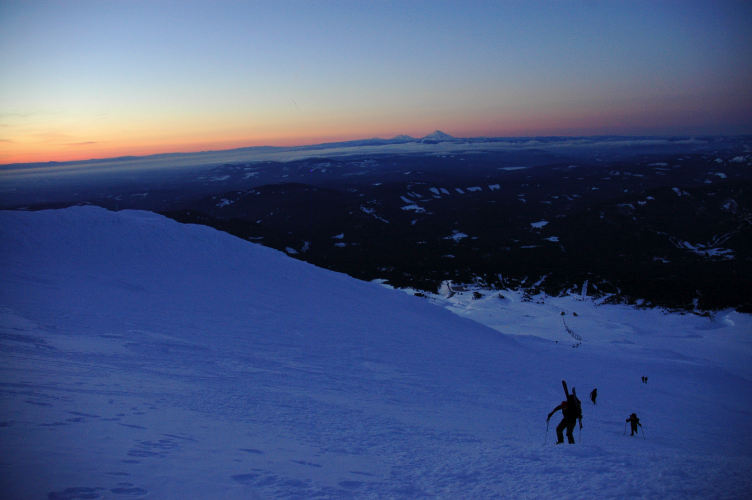
Down low, in Portland, say, there is still blackness. The light is only hitting things up high as the sun hasn't yet made it over the horizon. But up here, we can see the light. And the light is smacking the mountain and casting down upon the lowlanders the shadow of the mountain. It is impossible to see from any place other than the mountain itself. Even if they were awake, the dwellers in the towns below can't see it, because they are in it. But we can.

And as the world is lit, the clear morning air reveals things far away. To the south, Jefferson, the Sisters, and Broken Top (right to left) glowed pink and seemed almost friendly. Far past Broken Top sat another peak, barely visible. Perhaps Washington? Thielson? Something close to California.

I gawked and climbed, ignoring the general rule that says when you look, you look. When you climb, you climb. But don't mix the two. Ahead of us was Crater Rock, a large, prominent formation that we were aiming for. Beyond it lay the Hogsback and the the rim of the crater, which would take us to the summit.

Although the world was lighting up, we were still in the cold shadow of the mountain. By 8 we had rounded Crater Rock and were staring at the Hogsback eating sandwiches that Vanessa had made for us. We had been moving consistently for some time and had to put some fuel back in us for the last push to the top, despite the cold air. A solitary climber was waiting on the Hogsback for four other climbers to make it through the Pearly Gates. The Gates are the shortest way to the top, but involve some steep climbing and high potential for party inflicted rock and ice fall. Two of the people in the gates were barely moving (you can see them in the below photograph), while the other two were only slightly moving.

Wayne and I started up toward the Hogsback in attempt to generate some body heat and escape the heavy sulfur smell that hung in the air. The Hogsback was just coming into sun as we topped out on it and luxuriated in the warmth of the sun. The solitary climber had moved up the Hogsback and was climbing around the lower two climbers, who were still in the same position after 45 minutes. The upper two climbers were out of sight. Wayne and I scoped out the other route to the top, the West Crater Rim. Rather than join the cluster in the Pearly Gates, it seemed like a much better idea to dodge left off the Hogsback, traverse over, and them climb directly to the rim. Some old steps were visible, so someone had gotten through it in the past. Kevin and Vanessa joined us just as we were getting set to head out, our fingers and toes now defrosted.

The Hogsback was a ridge of snow, narrow in some places, kind in others. The risk of falling was minimal, and the run out below the Hogsback was good. I had heard that many parties rope up and belay each other along the Hogsback, but that must be in the spring and summer when things are thinner. Now, in February, it was an easy stroll.

Wayne led the way up, improving the steps left by the other climbers, moving slowly and surely. We were not in a rush and were feeling the beginning stages of exhaustion. In the below photo, you can see the two lower climbers still in the same position more than an hour after we first saw them. They are the two black dots to the right of Wayne, in a shadow, in a gully.
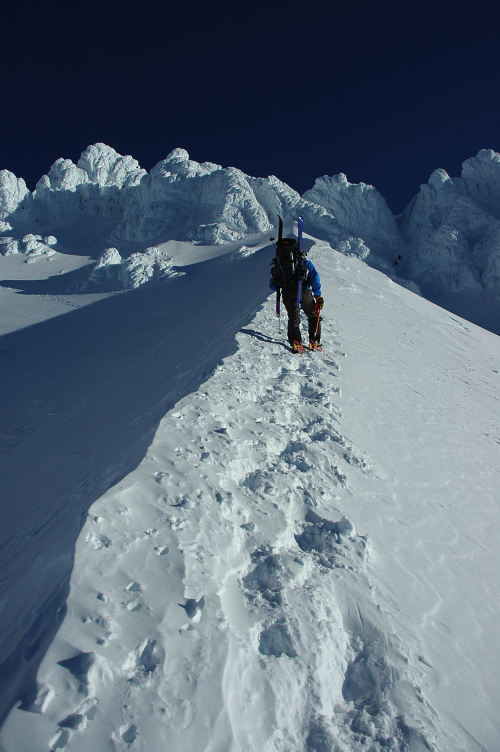
Near the top of the Hogsback we moved left off of it and gently danced across hard, icy snow to some old tracks where the going was easier. Wayne still had to kick steps, however, as wind-deposited snow and solar radiation had reduced many of them to mere symbols. Occasionally shards of ice would hit me in the helmet from the rocks above, and ominous sign for those to follow.

The reason for alpine starts is to try to climb past the dangers of rock and ice fall before they come into play. On warm days, the sun melts out weaker bonds, releasing chunks of rock and ice. I was getting hit by small bits. However, as the day warmed the chances of getting something big coming at you were much higher. On the kind of slopes we were moving across, there wasn't a lot of room to dodge about.

We finished the traverse and I took over in front to spell Wayne, who had been leading for a while. The grade steepened to 45 degrees and kicking steps began to get very tiring. The hard crust underneath meant that I couldn't get a whole, or even half, of a foot into the slope and I frequently had to scratch away with the front points of my crampons to get a mere toe hold. I was quickly exhausted and had to move upward in blocks of six or eight steps. To make matters worse, there was nowhere to get a solid rest and take the pressure off of my calves: The land was steep enough that one or both of my legs were always under a load. The last push to the rim was so exhausting that when I got up there, all I could do was sit in the snow and rest. I barely even looked over the edge to see Rainier, Adams, and St. Helens. Wayne called down from below. I shook my head and pointed left to indicate that we were not at the top. Wayne joined me five minutes later, five minutes to climb the last 100 vertical feet. We were spent. Kevin and Vanessa joined us after another five minutes and we set off to run the rim to the summit.

Fortunately, the true summit wasn't very far away. After a short snow knife-edge, where the mountain dropped away for a thousand feet on one side, the rim widened out and led across a broad plateau to the actual summit. We were all giddy, especially when we found that we were the only ones on top. The solo climber had passed us on the way down, having gotten through the Pearly Gates. The other climbers had not yet made it through them, despite several hours of trying. It was sunny and warm and the wind was barely a breath. We were definitely going to have to pay for this day at some point in the spring with a climb full of misery. But today we celebrate.

We posed and strutted and bragged. Kevin did the Worm on top.
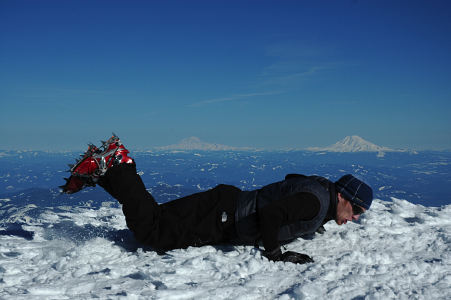



It was 9:40 am, six hours after leaving from Timberline. According to one guidebook, we had finished 2.5 hours faster than recommended. We were tired. Slowly the various climbers who we had seen from above began to filter in, with huge smiles on their faces. Everyone knew how fortunate we were for the weather. We stayed on top for more than an hour lounging in the sun and enjoying the views. California, just out of sight, to the south. Washington and Canada, also just out of sight, to the north. The Columbia River running across the scene with the brown sage hills of eastern Washington and Oregon crashing into the lush green of the west slopes of the Cascades. Portland down below. The orchards of Hood River. Everything. But it was time to go. For Wayne, this meant a ski descent.

Not being a skier, it is hard to judge difficulty. But what Wayne was getting ready to do scared me. It scared Vanessa enough that she couldn't watch. The slope was steep and icy and there was a narrow slot to pass through below us. But Wayne was confident.

He started side slipping down hill (survival skiing, he called it). The sound of the skis scraping against the icy slope sounded like some demon raking his claws down Judas's back. Slowly, but in control, Wayne made it down to the slot, and then through.

He gave us the thumbs up and we started down. Just before turning in to face the slope for downclimbing, I saw him rip out to the softer snow below.

I downclimbed the slope, using some steps that the Mazamas, who were below me, had kicked out. From above, I was getting hit by a constant rain of ice chunks knocked loose by some climbers. They were not doing it intentionally, but I was glad I had a helmet on and took several shots on the arms that numbed my hands for a while. I didn't dawdle. Further down I saw Wayne evaluating a snow pit that he had dug to assess avalanche danger, and then go careening down the slope to the Hogsback, cross it, and race down the other side.

The downclimbing only lasted to the point where I had taken over from Wayne in the morning, but I was stuck behind the slow moving Mazamas (beginning climbers on steepish terrain). No matter. The view was immense and the weather stable. It was, however, roasting hot and I still had on my morning layers.
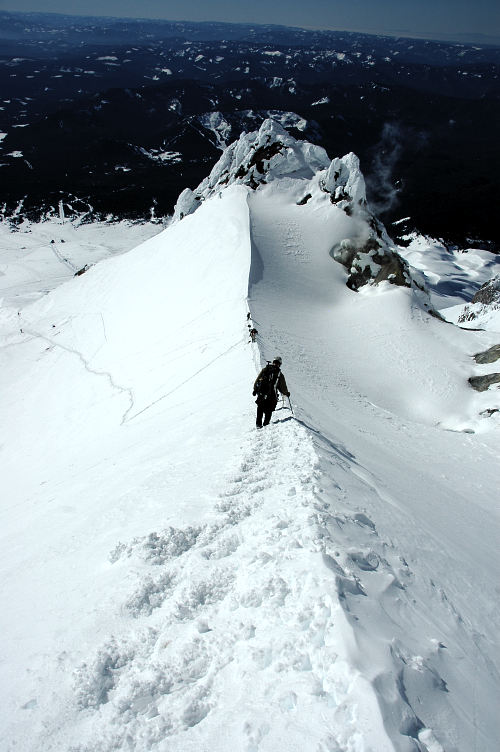
I wallowed through the snow and joined Wayne at our sandwich spot to rest, strip down, and wait for the others, who were stuck behind yet more Mazamas. We chatted with two of them for a while, and dodged a rather large ice fall that screamed down at us from above. Not having the sense to move on, we continued to chat. Kevin and Vanessa reached us and started their own rest. And then another large ice fall came at us, nearly hitting me. That was enough for Wayne, who took off on his skis, and for the two Mazamas, who set off on foot. The three of us trudged down the hill slowly, to the point where Kevin had left his skis. The sun was hot and the reflected light was roasting us. I drank the last half liter of water that I had and hoped for the best on the rest of the descent. Kevin and Wayne took off on their skis blazing downhill.
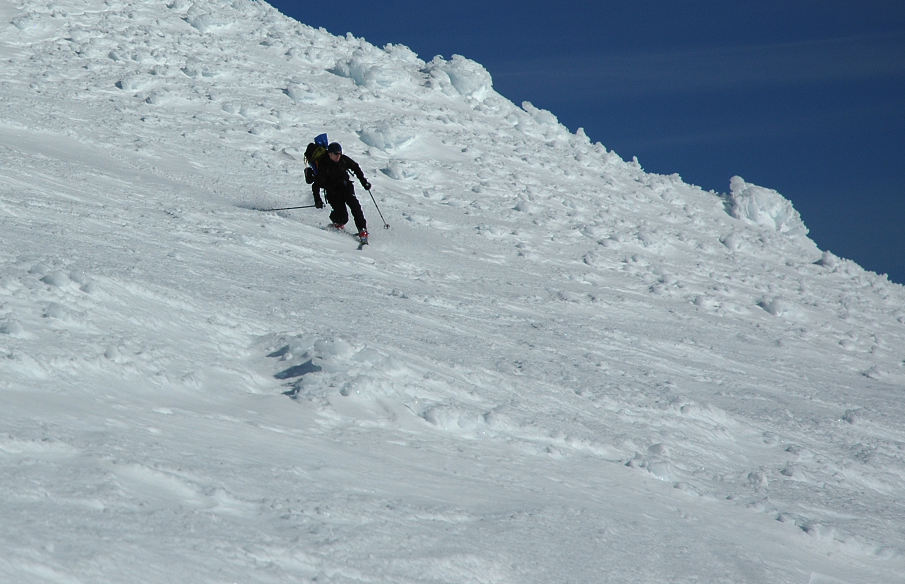
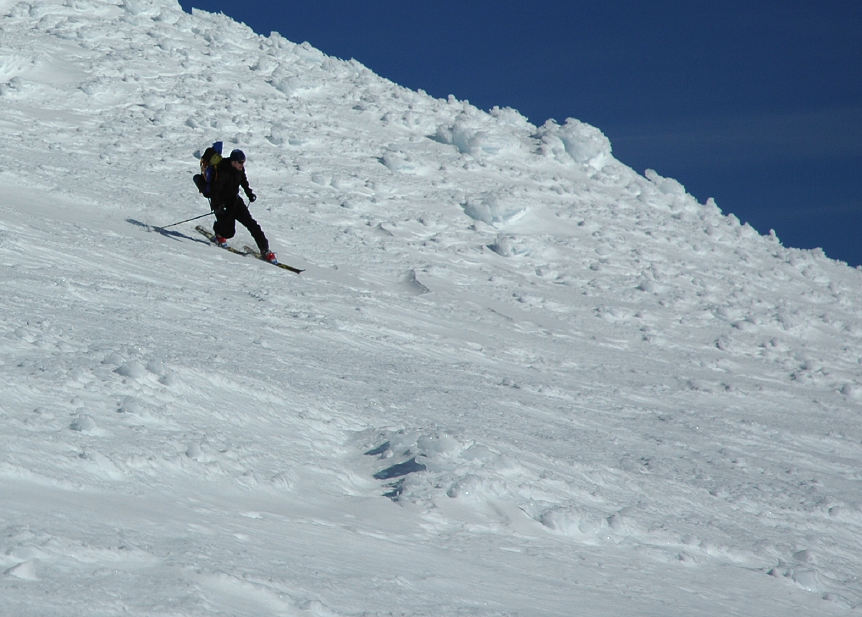
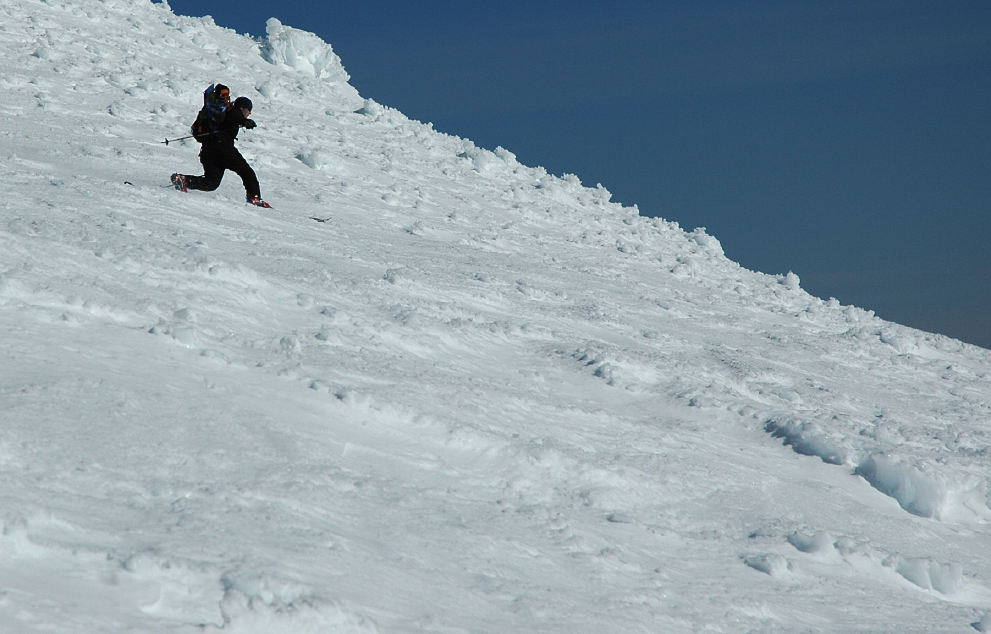
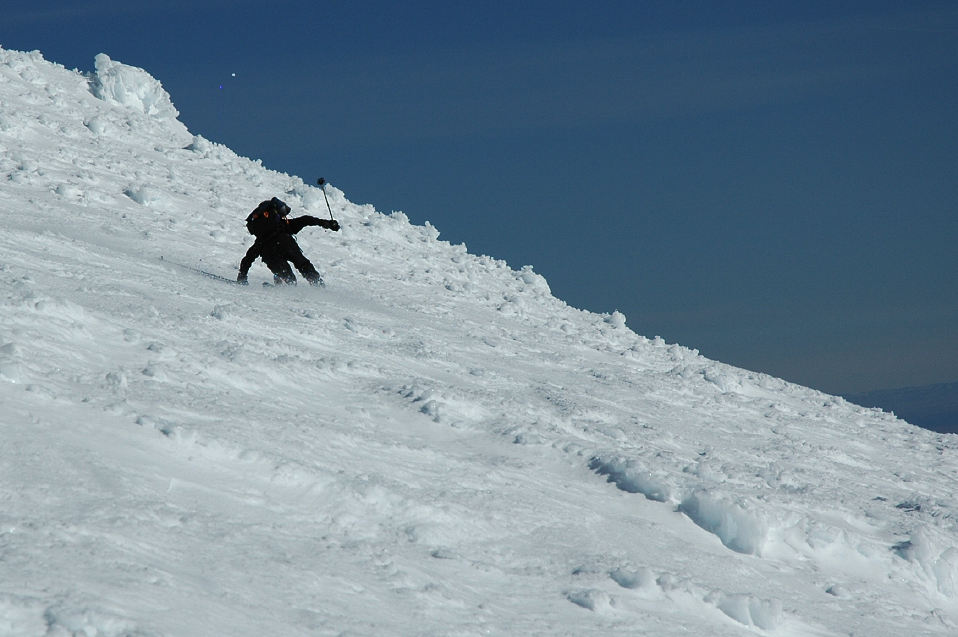
It was a long, long, hot, hot, walk down the hill to the parking lot. Never had I wished more for a sled than then. I reached the parking lot dehydrated, limping, and tired. But also happy. Vanessa and I de-geared in the parking lot, amidst hundreds of skiers, snowboarders, and families out enjoying their land. There wasn't much time to wax philosophic, or to reflect on what we had just done. It was time for beer, and the skiers had a forty minute head start on us.

Logistics
From Lakewood, drive I-5 south toward Portland and take I-205 heading south toward Salem. Pick up I-84 heading east. Turn off at exit 16, following the signs for Mount Hood and US 26. Once on US 26, follow it east to the town of Government Camp, just past which you'll find the road heading up to Timberline Lodge. Follow the road up and park in the massive ski complex parking area. You do not need a parking pass here during the summer but you do need a snow park pass during the winter.
From Timberline Lodge, follow the ski lifts up the Palmer Glacier. Once above the top of the highest one, locate Crater Rock, which is the big, prominent rock in the middle of the mountain. Aim for just to the right of it. Follow along the right side until you reach the Hogsback, a narrow ridge of snow. Follow the Hogsback to its end and climb through the Pearly Gates, if they are in. Otherwise, drop off left of the Hogsback and traverse around and then up to the crater rim. Follow it a short distance to the summit. The climb is about 3.5 miles in length and gains about 5000 feet in elevation. The climb is fairly non-technical up to the Hogsback. After the Hogsback, things get steep and it would not be a good place to bring beginners.


































